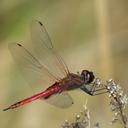United States and Canada
This species is predominantly found in the Bahamas and Greater Antiles but is fairly common in southeastern Florida and ranges into Mexico and Texas. The face is brown in females and young males but becomes black in mature males. The top of the head is metallic violet. The thorax is brown and unmarked. The wings have predominantly red veins anteriorly and the hindwings each have a brown basal crossband. The legs are black except at their extreme bases. The abdome n is red, except segments 8, 9 and sometimes 10, which are black dorsally.
Size: Total length: 41-48 mm; abdomen: 26-31 mm; hindwing: 36-40 mm.
Similar Species (south-central US): Hyacinth Glider (Miathyria marcella) is smaller and has a dark middorsal stripe running the length of the abdomen. Aztec Glider (Tauriphila azteca) has dark thorax and a yellow abdomen.
Habitat: Ponds, lakes and slow streams.
Natural History: In our region, this species is only known from a couple of localities in west Texas including, Big Bend National Park, the Devils River and Ft. Clark Springs near Brackettville. There are apparent breeding populations in both localities and I suspect this species may become more common in Texas as it further establishes itself. Individuals can be seen flying quickly at great heights.
Distribution: Florida, southern and Western Texas; also Mexico, Bahamas and Greater Antiles.
Source: Abbott, J.C. 2006-2010. OdonataCentral: An online resource for the distribution and identification of Odonata. Available at OdonataCentral.
Edited by Drew Weber (9/24/2015).
